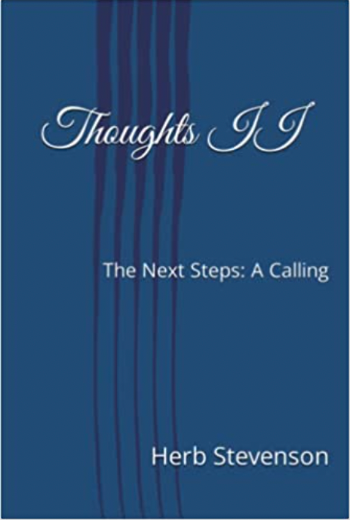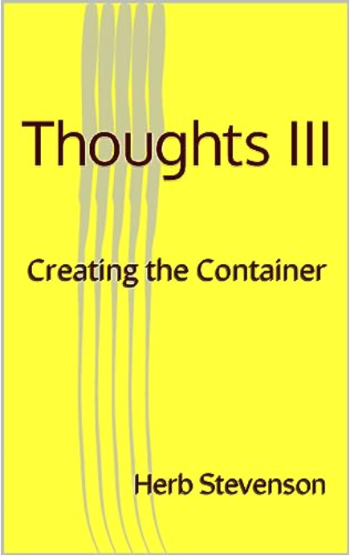

A book by Herb Stevenson, Volume 1. Learn more on Amazon.
Thoughts II:
The Next Step: A Calling

Volume 2 of 3. Learn more on Amazon.
Thoughts III:
Creating The Container

Volume 3 of 3. Learn more on Amazon.
To Lead
Read the article about training with Herb Stevenson in ALN Magazine.
See the article...
SENIOR & EXECUTIVE LEADERSHIP COURSES AND PROGRAMS
The following is a schematic of the various senior and executive leadership courses provided by the Cleveland Consulting Group, Inc. Each course can be developed as a standalone for one day or as part of a larger program. For example, it is clearly divided and indicated in the section titles that there are three levels of system required for senior and executive leaders—self awareness, group and team dynamic, and systems/organizations awareness.
Presently, the entire three week program as presented here has been adopted for the ADI-DIA Gemstone program. In its second iteration, the program has received accolades for its depth, application, and insight into executive development.
All individual sessions as well as the indepth three week program are formulated to teach and apply throughout the session. This process of "learn then do" overcomes Sutton’s “Knowing-Doing Gap” that preempts the success of many executive programs.
The schematic lists the session title in the left column, the session description in the middle column, and the minimum time required for either individual sessions or as part of a larger program.
Most of these sessions have been designed around specific levels of system, individual, group/team, organization. It is recommended to build your program with these levels in mind to maximize the effectiveness of your development program.
| Title | Description | Day(s) |
WEEK ONE: THE LEADER–AWARENESS & DEVELOPMENT |
||
| Leader Philosophies | Understanding one’s leadership philosophy is a developmental process of self-awareness, and learning to communicate as a senior/executive leader. Among the benefits:
Guided exercises are completed which results in a working draft of a leader philosophy with instructions on how to maximize its use through clear communication and implementation with all supervisors and direct reports. Can be more effectively completed with peers. When used as part of an executive development program, the final day of the class, each participant presents a 20 discussion on their process over the course of the program to integrate their learning into their leadership philosophy. This has become the profound closing for such programs. |
1 or 1.5 days Can be incorporated as developmental assignment. Presently in ADI-DIA Gemstone Program. Three one week sessions held over a four month period |
| Leadership Development | Utilizing the 3 decades of research from Zenger & Folkman that resulted in the book, “The Extraordinary Leader, and the extensive research on derails from a variety of sources, the foundation of how to build on existing leadership strengths without turning an over used strength into a weakness, a common occurrence in many strength based programs. Core leader competencies for middle managers, senior leaders, and executives are reviewed to indicate what leads to executive success. Within these competencies the inter-relationship between competencies are revealed. This inter-relationship of competencies enables the individual to expand a strength into an extra-ordinary leadership competency. |
One full day or 1⁄2 day as part of a program. Presently in ADI-DIA Gemstone Program. |
| GOOD Coaching Model |
Coaching has become a core competency for senior/executive leadership. Most leaders do not have a clear sense of what is coaching nor how to effectively do it. The GOOD coaching model involves 4 steps for every coaching session. (1) Goals/Purpose: Come to agreement on the purpose of the session and at least one goal. (2) Option: Various options/ opportunities are explored. (3) Obstacles: Most failures are the result of not clearly examining the obstacles. (4) Desired Action/Actionable Items: The final step is to come to agreement on “next steps. The dialogic aspect of this model makes it highly effective. This model is highly integrated in all sessions to deepen the learning of the participants and to further develop a coaching competency. |
1⁄2 day or part of a program. Presently in ADI-DIA Gemstone Program. |
| MBTI Step 2 Form Q | The focus is on leader self awareness and leadership development. The MBTI Step 2, Form Q is the only version that includes leader flat sides to the preferred ways of engaging (introvert/extrovert), taking in information (sensing/intuition), making meaning of the information (thinking/feeling) and ways of dealing with the information (structured/feeling). This tool supports individual development plans and leader philosophy statements. Often used with GOOD model. |
1⁄2 day or part of a program. Presently in ADI-DIA Gemstone Program. |
| Thomas Kilmann Instrument (Conflict Styles) |
The focus is on leader self-awareness and leadership development. The TKI describes the leader’s conflict style and includes the flat sides to the preferred ways of dealing with conflict. Using the relationship between level of assertiveness and cooperation, the preferred conflict style will be determined as competitive, compromising, collaborative, avoiding or accommodating. This tools supports individual development plans and leader philosophy statements. Often used with GOOD model. Can be combined with MBTI Step 2, Form Q and Firo-Business. |
1⁄2 day or part of a program. Presently in ADI-DIA Gemstone Program. |
| Firo-Business Interpersonal Relations Preferred Style | The focus is on leader self-awareness and leadership development. The FIRO-Business describes the leader’s interpersonal relations style and includes the flat sides to the preferred ways of dealing with people. Using the Expressed versus Wanted needs surrounding connection (warmth, understanding, closeness, openness, and how one relates to individuals), influence (control, leadership, responsibility, and decision-making authority, and involvement (inclusion participation, recognition, belonging, and how one relates to groups), the assessment describes how the leader interpersonally orients to others in the organization. This tool supports individual development plans and leader philosophy statements. Often used with GOOD model. Can be combined with MBTI Step 2, Form Q and TKI. |
1⁄2 day or part of a program. Presently in ADI-DIA Gemstone Program. |
| Three Dimensional Leader Assessment | Using the MBTI Step 2, Form Q, the Thomas Kilmann Instrument, and the FIRO-Business assessments, a three-dimensional portrayal of the leader’s overall leadership style can be created. The impact is that the leader has a three dimensional perspective of how he or she orients in the leadership position in terms of meaning making, conflict, and interpersonal styles. These insights are quite revealing and begin the process towards greater leadership effectiveness. Individual development plans are created at the end of this process. Leader philosophy statements can be supported as well. |
2 days or part of a program. Presently in ADI-DIA Gemstone Program. |
| Leader Resilience | The focus is on leader capability to address a VUCA (Volatile, Uncertain, Complex, Ambiguous) environment. Providing insights into how the leader stays engaged through one’s sense of commitment (you want to stay involved with people and events going on around you, as that seems the best way to find what is experientially interesting and meaningful), control (you want to struggle to have an influence on the outcomes going on around you, even if this may seem difficult in certain circumstances), and challenge (you find the process of continuing to learn from your experiences, whether they are positive or negative, developmentally fulfilling) determines the level of resilience and therefore likelihood for success in a constant white water situation. Very applicable to today’s ever-changing world. Examples are drawn from the class in group discussions as well as interspersed with use of the GOOD model to deepen coaching skills and to undercover "real time" applications for the attendees. |
One full day or 1⁄2 day as part of a 5 day program. Presently in DIA Gemstone Program. |
| Learner versus Judger: A Matter of Perspective | The focus is on leader capability to stay focused on possibility and learning from every moment or interaction versus falling into the judger mode where the focus is on what’s wrong. Provides insights into leader preconceived notions of how to approach critical situations. Very applicable to today’s ever-changing world where morale can drop unless leadership has a clear sense of self and the clear positive leadership forward. Examples are drawn from the class in group discussions as well as interspersed with use of the GOOD model to deepen coaching skills and to undercover "real time" applications for the attendees. |
One full day or 1⁄2 day as part of a 5 day program. Presently in ADI-DIA Gemstone Program. |
WEEK 2: LEADERSHIP & GROUP/TEAM DYNAMICS |
||
| The Abilene Paradox | The inability to manage agreement, not the inability to manage conflict, is the essential symptom that defines organizations caught in the web of the Abilene Paradox. Organization members fail to accurately communicate their desires and/or beliefs to one another. In fact, they do just the opposite and thereby lead one another into misperceiving the collective reality. Provides insights into how the Abilene paradox can seep into any organization and what to do to prevent it. Very insightful program for organizations in chaotic environments. Examples are drawn from the class in group discussions as well as interspersed with use of the GOOD model to deepen coaching skills and to undercover "real time" applications for the attendees. |
One full day or 1⁄2 day as part of a 5 day program. Presently in ADI-DIA Gemstone Program. |
| The Spiral of Silence | One of the theories that led to the discovery of the Abilene Paradox. Originally proposed by German political scientist Noelle-Neumann in 1974, Spiral of silence is the term meant to refer to the tendency of people to remain silent when they feel that their views are in opposition to the majority view on a subject. Positional power dynamics, politics, and unwritten rules of surviving can rock a team into oblivion. The spiral of silence occurs when we perceive that the prominent opinion is contrary to our own and that to make our countervailing opinion would be harmful in some form. Provides insights in team dynamics that can be counterproductive. In highly chaotic environments, understanding the spiral of silence can prove invaluable. Examples are drawn from the class in group discussions as well as interspersed with use of the GOOD model to deepen coaching skills and to undercover "real time" applications for the attendees. |
1⁄2 day or part of a program. Presently in DIA Gemstone Program. |
| The JoHari Window | The JoHari Window was developed by American psychologists Joseph Luft and Harry Ingham in the 1950's, while researching group dynamics. It is a useful tool for illustrating and improving self-awareness, and mutual understanding between individuals within a group. It can also be used to assess and improve a group's relationship within and with other groups. Provides insights into the dynamic relationship between appropriate levels of disclosure and feedback that can ultimately lead to team trust and effectiveness. Leader understanding of this balance between disclosure and feedback can dramatically increase effectiveness. |
One full day or 1⁄2 day as part of a 5 day program. Presently in ADI-DIA Gemstone Program. |
| Tuckman’s Stages of Team Development | Bruce W. Tuckman first described the stages of group development in 1965. Looking at the behavior of small groups in a variety of environments, he recognized the distinct phases they go through, and suggested they need to experience all stages before they achieve maximum effectiveness. Understanding the team stages of forming, storming, norming, performing, and adjourning is a critical component of leadership effectiveness. Provides insights into the five stages as well as the leader’s most effective leadership in each stage. Examples are drawn from the class in group discussions as well as interspersed with use of the GOOD model to deepen coaching skills and to undercover "real time" applications for the attendees. |
1⁄2 day of a full day training combined with the 5 dysfunctions of teams or part of a program. Presently in DIA Gemstone Program. |
| 5 Dysfunctions of Teams | Developed by Patrick Lencioni, the five dysfunctions of teams provides insights into why some teams never fully perform. Tying the 5 dysfunctions to the stages of group development, it becomes clear why some teams never get through the second stage of development (storming) and therefore never effectively perform as a team. Provides deeper understanding into team dynamics (absence of trust, fear of conflict, failure to fully commit, avoids accountability, and individual results orientation)and the importance of creating the capacity for the team to develop the capacity for constructive conflict. Examples are drawn from the class in group discussions as well as interspersed with use of the GOOD model to deepen coaching skills and to undercover "real time" applications for the attendees. |
1⁄2 day of a full day training combined with the stages of team development or part of a program. Presently in DIA Gemstone Program. |
| Influence | A core competency for all senior and executive leadership. Often confused or associated with persuasion and coercion, real influence isn’t just about getting what you want. It’s about making sure the people who matter to you get what they want. This full day training provides insights into the currencies of influence, the relational requirements, and the continued efforts require to be influential. It describes connected versus disconnected influence and the pitfalls of not knowing the difference. It clarifies internal and external barriers that impact the ability to influence. This is becoming a critical training in many organizations. Examples are drawn from the class in group discussions as well as interspersed with use of the GOOD model to deepen coaching skills and to undercover "real time" applications for the attendees. Recent survey of program attendees revealed that not one developing executive had received any formal training on influence. |
1 day or part of a 5 day program. Presently in ADI-DIA Gemstone Program. |
WEEK 3: LEADERSHIP & ORGANIZATION DYNAMICS |
||
| VUCA | VUCA (Volatile, Uncertain, Complex, Ambiguous) was created by the military in the 1990's. It has been subsequently used in emerging ideas in strategic leadership that apply in a wide range of organizations. The deeper meaning of each element of VUCA serves to enhance the strategic significance of VUCA foresight and insight as well as the behavior of groups and individuals in organizations. VUCA elements:
Understanding the sense of constant white water that belies most organizations is becoming the difference between clear leadership and those that naively set a dangerous direction. It requires a new leadership competency that understands setting direction is a constant shift of course that creates a jagged albeit straight line to the desired result. Examples are drawn from the class in group discussions as well as interspersed with use of the GOOD model to deepen coaching skills and to undercover "real time" applications for the attendees. |
One full day or 1⁄2 day as part of a 5 day program. Presently in ADI-DIA Gemstone Program. |
| 8 Stages of Change | The last 10 years have seen all organizations go through massive upheaval. Senior/executive leaders are being called to task to unify the organizations into a synergistic organization. Pulling on the life work of John Kotter, this training provides insights on how to manage an organizational change. Critical components such as understanding managing versus leading and the difference between real urgency and how it cannot be confused with priorities or massive breakdowns occur in the change process that can lead to the inability to sustain the change. From an organizational perspective, this training is imperative for system leaders and organizational leadership. Examples are drawn from the class in group discussions as well as interspersed with use of the GOOD model to deepen coaching skills and to undercover "real tim" applications for the attendees. |
One full day or 1⁄2 day as part of a 5 day program. Presently in DIA Gemstone Program. |
| Organizational Cycle of Change | Gestalt theory provides a unique way to look at organization/system change. Called the organizational cycle of change, it pulls on organizational biologic theory to reveal the natural processes all organizational change moves through. This the tool reveals the stages of change including how to diagnose when a change process is stuck in one or more stages. Executives find this tool easy to use as well as easy to share with the rest of the organization when mapping a change and keeping it on track. Examples are drawn from the class in group discussions as well as interspersed with use of the GOOD model to deepen coaching skills and to undercover "real time" applications for the attendees. |
One full day or 1⁄2 day as part of a 5 day program. Presently in ADI-DIA Gemstone Program. |
| Systems Thinking | Most executive suffer from the lack of training for how to think strategically and in terms of larger systems. Zenger and Folkman have revealed that the inability to think strategically and at systems levels is a key career derailer at the executive level. Drawing on the work of Chris Argyris, Peter Senge, and others, the focus is on how to think in terms of systems and more importantly how to use the organization to create an ongoing evolving environment. This process is best taught in combination with the 8 stages of change, the Gestalt Cycle of Change and VUCA. Combined the executive is able to more fully under the 3-dimensional aspects of systems and organizations. Examples are drawn from the class in group discussions as well as interspersed with use of the GOOD model to deepen coaching skills and to undercover "real time" applications for the attendees. |
One full day or 1⁄2 day as part of a 5 day program. Presently in DIA Gemstone Program. |
| Finding Balance | The work/life balance has become an overused phrase to suggest that there must be a literal balance similar to a 50/50 relationship between work and life. In fact, there is no formula for an ideal balance. Most executives spend more time in work related functions than they do at home. However, successful executives at work and at home have negotiated the amount of time for each and how to ensure that both received high quality attention whether it relate to spouses, children, friends, and overall home life. This session is highly experiential as the attendees walk through a series of questions that provoke deep though and discussion that is carried over into the home after the session. Examples are drawn from the class in group discussions as well as interspersed with use of the GOOD model to deepen coaching skills and to undercover "real time" applications for the attendees. |
One full day or 1⁄2 day as part of a 5 day program. Presently in ADI-DIA Gemstone Program. |

